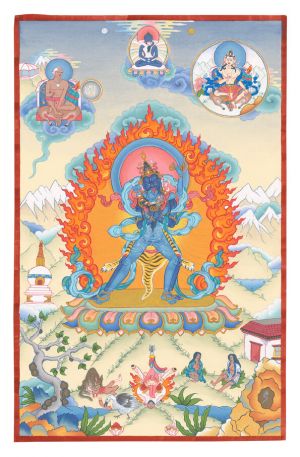The nature of mind and the nine yanas…
Each explanation of the nine vehicles begins with a discussion about the essence of Sugatas, which is the fundamental essence or Buddha nature of all beings. Depending on the essential nature that we possess, the nine vehicles appear. Depending on the fundamental nature, samsara and nirvana arise. If the fundamental nature of mind is realized as it is, this is nirvana, a state beyond sorrow and suffering. If this is not realized, the fundamentally of one’s own Buddha-nature is not aware, this is samsara, the cyclic existence. By not realizing one’s own Buddha nature, the various experiences or states of cyclic existence are established. The six classes of beings appear only through their lack of awareness. The nine vehicles are also created in order to lead sentient beings back to the realization of their own nature, which is nirvana.
If we examine these fundamental Buddha-nature, the essential nature of all sentient beings, we come to understand that it is completely open. It is a vibrant emptiness. Its characeristic quality is a natural luminosity. It is sheer luminosity or clear light. If anyone understands that it is open and bright clear, you hear with your pure awareness compassionate quality that it is pervasive. This is the property of Rigpa, pure awareness. In this way, the three – openness, clarity and compassion – are really one. Although they are represented as three, they are only the fundamental Buddha-nature itself. This is the state of Buddha, the is Buddha, because of that it is also called Buddha-nature. Samsara is a state of confusion and false awareness. The mistake – actually causes the cyclic existence, the experience of a being, a sentient being instead of being a Buddha – arises when we forget to recognize that very nature. In this state of awareness, lack of awareness we are creating an object, we create objects: external phenomena.
To illustrate the nature of mind specifically, the comparison is used with space. The mind is like space, because space has no form, no color and no features. It is completely free of any conditions or characteristics. In this way, the example provides a useful comparison of space to illustrate the nature of mind, but there are other aspects of the mind – its brilliant clarity and unobstructed compassion – are not necessarily characteristics of space.
If we do not achieve a clear understanding of the nature of mind, then we have a mess. If even the smallest modicum of confusion exists, then we are creating objective appearances due to the lack of awareness, because we do not realize the true nature of mind as the empty quality of mind. If we are not aware of its luminosity, the natural clarity of mind, we do not see the expression of the enlightened presence – the kaya’s primordial wisdom and energy – especially the five primordial wisdoms as they appear. If we are not aware the empty nature’s intrinsic expression, we are creating an external universe and sentient beings as animate creatures in it. If we do not realize the unobstructed compassionate nature, then this leads to views about it. In this way, appearences of objectness, especially sentient beings and concepts. These three: objects (or phenomena), (physical) forms and views are the confused interpretation of the nature of mind, which is emptiness, clarity and compassion. Therefore, samsara appears from what has actually been released, what is the Buddha-nature. Due to the confusion, lack of awareness, we are creating samsara in awareness of the nature of mind itself.
